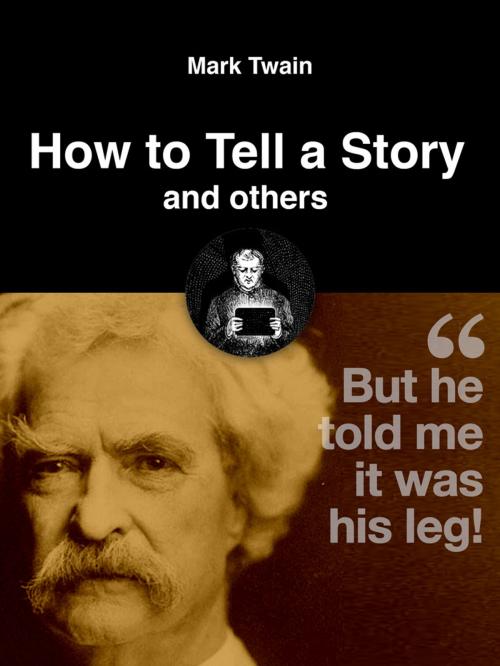| Author: | Mark Twain | ISBN: | 9786069346150 |
| Publisher: | Read Forward LLC | Publication: | April 28, 2013 |
| Imprint: | Language: | English |
| Author: | Mark Twain |
| ISBN: | 9786069346150 |
| Publisher: | Read Forward LLC |
| Publication: | April 28, 2013 |
| Imprint: | |
| Language: | English |
Picture this:
”An American, an Englishman and a French walk into a bar and…”
This could be the beginning of:
1. a joke
2. a humorous story
3. a beautiful friendship
4. all of the above
Or maybe, after reading Mark Twain’s ”How to Tell a Story and Other Essays,” this could be the beginning of your apprenticeship as a storyteller. In case you already master the art of telling a good joke, it will surely hone your craft.
Because this book is that little rare gem that will delight you while at the same time teach you a trick or two about storytelling. If Mark Twain’s name rhymes with humour and wit, there must be a reason in there that he is willing to disclose in this five-piece volume on the art of crafting a well-told humorous story.
”There are several kinds of stories,” Mark Twain says, ”but only one difficult kind—the humorous. I will talk mainly about that one. The humorous story is American, the comic story is English, the witty story is French. The humorous story depends for its effect upon the manner of the telling; the comic story and the witty story upon the matter.”
To exemplify this, Mark Twain gives a few examples of humorous stories, accompanied by useful tips about how to tell them in order to obtain the effect of impressing the audience, especially the occasional well-chosen girl. ”The Wounded Soldier,” ”The Golden Arm,” ”Mental Telegraphy Again,” and ”The Invalid’s Story” are the funny other ”essays” that will let you have a glimpse at Twain’s technique of building up suspense and anticipation in a story meant to provoke laughter and surprise.
Oh, and since all humorous stories should be taken/read with a grain of salt, the following quote from Huckleberry Finn—that first, best and most candid of literature’s stand-up comedians—could be a (funny) thread to follow while emerging yourself into this brief but truly rewarding reading experience.
“Persons attempting to find a motive in this narrative will be prosecuted; persons attempting to find a moral in it will be banished; persons attempting to find a plot in it will be shot.
BY ORDER OF THE AUTHOR
per G.G., CHIEF OF ORDNANCE”
(Mark Twain, The Adventures of Huckleberry Finn)
And after you have learnt your trade, do stop by again and drop us a joke. We can’t promise to find it amusing, but hey, you can try again until you get it right.
…And, here we will stop now because we also learnt a lesson from Mark Twain, which goes like this:
”Explaining humour is a lot like dissecting a frog, you learn a lot in the process, but in the end you kill it.”
Croak, croak.
Picture this:
”An American, an Englishman and a French walk into a bar and…”
This could be the beginning of:
1. a joke
2. a humorous story
3. a beautiful friendship
4. all of the above
Or maybe, after reading Mark Twain’s ”How to Tell a Story and Other Essays,” this could be the beginning of your apprenticeship as a storyteller. In case you already master the art of telling a good joke, it will surely hone your craft.
Because this book is that little rare gem that will delight you while at the same time teach you a trick or two about storytelling. If Mark Twain’s name rhymes with humour and wit, there must be a reason in there that he is willing to disclose in this five-piece volume on the art of crafting a well-told humorous story.
”There are several kinds of stories,” Mark Twain says, ”but only one difficult kind—the humorous. I will talk mainly about that one. The humorous story is American, the comic story is English, the witty story is French. The humorous story depends for its effect upon the manner of the telling; the comic story and the witty story upon the matter.”
To exemplify this, Mark Twain gives a few examples of humorous stories, accompanied by useful tips about how to tell them in order to obtain the effect of impressing the audience, especially the occasional well-chosen girl. ”The Wounded Soldier,” ”The Golden Arm,” ”Mental Telegraphy Again,” and ”The Invalid’s Story” are the funny other ”essays” that will let you have a glimpse at Twain’s technique of building up suspense and anticipation in a story meant to provoke laughter and surprise.
Oh, and since all humorous stories should be taken/read with a grain of salt, the following quote from Huckleberry Finn—that first, best and most candid of literature’s stand-up comedians—could be a (funny) thread to follow while emerging yourself into this brief but truly rewarding reading experience.
“Persons attempting to find a motive in this narrative will be prosecuted; persons attempting to find a moral in it will be banished; persons attempting to find a plot in it will be shot.
BY ORDER OF THE AUTHOR
per G.G., CHIEF OF ORDNANCE”
(Mark Twain, The Adventures of Huckleberry Finn)
And after you have learnt your trade, do stop by again and drop us a joke. We can’t promise to find it amusing, but hey, you can try again until you get it right.
…And, here we will stop now because we also learnt a lesson from Mark Twain, which goes like this:
”Explaining humour is a lot like dissecting a frog, you learn a lot in the process, but in the end you kill it.”
Croak, croak.















